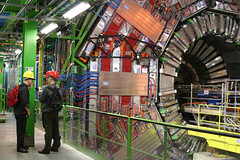
Moderators: Elvis, DrVolin, Jeff
Allegro wrote:
Thanks, hanshan. Since I don’t know the works of either Mr. Brunner or Mr. Constantine, I think, from a personal point of interest with regard to the scale of things, the more scientifically specific would be cosmological ideas expressed in an excerpt that I’ve personally transcribed from David Deutsch’s TED talk. The only thing is, and it’s not surprising, Deutsch didn’t include shock or sound waves, or vibrations ftm, in his hypotheses. However, when I first heard Deutsch’s talk, I don’t think I could’ve been more excitedlydazed for days.
The excerpt begins approx 07.45.
^ David Deutsch | TED JULY2005“…The brain contains an accurate, working model of the quasar; not just a superficial image of it—though it contains that as well—but an explanatory model embodying the same mathematical relationship, and the same causal structure. That is knowledge.
“And, if that weren’t amazing enough, the faithfulness with which the one structure resembles the other is increasing with time. That is the growth of knowledge.
“So the laws of physics have this special property: that physical objects, as unlike each other as they could possibly be, can nevertheless embody the same mathematical and causal structure, and to do it more, and more so over time.…”
POST 2671

 The Cocoon nebula is a well-known gas cloud being lit up by a massive, hot star in its center. In the visible light image inset here — grab the stunning high-res version to compare to the Herschel shot — the dust is dark, since it absorbs the kind of light we see. Also, stars are pretty faint at these extreme infrared wavelengths, so they don’t interfere with the observations of the gas and dust. That’s why observatories like Herschel are so important: they allow us to investigate objects that might be invisible to other telescopes.
The Cocoon nebula is a well-known gas cloud being lit up by a massive, hot star in its center. In the visible light image inset here — grab the stunning high-res version to compare to the Herschel shot — the dust is dark, since it absorbs the kind of light we see. Also, stars are pretty faint at these extreme infrared wavelengths, so they don’t interfere with the observations of the gas and dust. That’s why observatories like Herschel are so important: they allow us to investigate objects that might be invisible to other telescopes. These filaments are all over the sky; the image here from Herschel is actually of a region on the sky near the star Polaris (click to get a much bigger, very cool picture), which I would’ve thought would be nearly empty of dust. But clearly there are filaments galore there, and again they show that same characteristic width of 0.3 light years. Apparently supernovae have been going off all over the galaxy for quite some time, their expanding gas stirring up the ethereally thin material of interstellar space. In fact, these filaments are considered by astronomers to be dense, but the air in Earth’s atmosphere is hundreds of trillions times denser!
These filaments are all over the sky; the image here from Herschel is actually of a region on the sky near the star Polaris (click to get a much bigger, very cool picture), which I would’ve thought would be nearly empty of dust. But clearly there are filaments galore there, and again they show that same characteristic width of 0.3 light years. Apparently supernovae have been going off all over the galaxy for quite some time, their expanding gas stirring up the ethereally thin material of interstellar space. In fact, these filaments are considered by astronomers to be dense, but the air in Earth’s atmosphere is hundreds of trillions times denser!In astronomy, thin means thin. But over trillions of kilometers, even material that rarefied can eventually condense from gravity and form mighty stars.
The Universe is a lesson in superlatives, from thin to dense, from huge to huger, from chillingly cold to searingly hot. And, as usual, the beauty of the images themselves is rivaled by the beauty of the science and knowledge we derive from them.
You’re Welcome.hanshan wrote:...
We would hazzard the observation that thin means thin in all disciplines...
tx - waayy coool ...
 .
. 
























Allegro wrote:You’re Welcome.hanshan wrote:...
We would hazzard the observation that thin means thin in all disciplines...
tx - waayy coool ...
Yes, well, in any discipline, “thin means thin”, until it’s thinner or thicker.
The Laws of Physics will not be denied.
Spoken as a paragon of physics, of course.
(For new readers, green indicates sarcasm at RI.)




25SEP12, 01:00 PM (EDT), a News Release Hubble NewsCenter wrote:September 25, 2012: Like photographers assembling a portfolio of best shots, astronomers have assembled a new, improved portrait of mankind’s deepest-ever view of the universe. Called the eXtreme Deep Field, or XDF, the photo was assembled by combining 10 years of NASA Hubble Space Telescope photographs taken of a patch of sky at the center of the original Hubble Ultra Deep Field. The XDF is a small fraction of the angular diameter of the full Moon. The Hubble Ultra Deep Field is an image of a small area of space in the constellation Fornax, created using Hubble Space Telescope data from 2003 and 2004. By collecting faint light over many hours of observation, it revealed thousands of galaxies, both nearby and very distant, making it the deepest image of the universe ever taken at that time. The new full-color XDF image reaches much fainter galaxies and includes very deep exposures in red light from Hubble’s new infrared camera, enabling new studies of the earliest galaxies in the universe. The XDF contains about 5,500 galaxies even within its smaller field of view. The faintest galaxies are one ten-billionth the brightness of what the human eye can see.
The public is invited to participate in a “Meet the Hubble eXtreme Deep Field Observing Team” webinar, where three key astronomers of the XDF observing team will describe how they assembled the landmark image and explain what it tells us about the evolving universe. Participants will be able to send in questions for the panel of experts to discuss. The webinar will be broadcast at 1:00 p.m. EDT on Thursday, September 27, 2012. To participate in the webinar, please visit: http://hubblesite.org/go/xdf/ .

 I visited the LHC a few years back, thanks to Brian Cox who brought me there for a tour and interview. This was shortly before the gigantic machine was switched on, so we went down 100 meters below the Earth’s surface to take a look. I stood off to one side of the CMS, and the scale of it was hard to grasp. It’s over 20 meters long, and weighs over 12,000 tons – 24 million pounds! A lot of that weight is from the huge slabs of iron you can see painted red.
I visited the LHC a few years back, thanks to Brian Cox who brought me there for a tour and interview. This was shortly before the gigantic machine was switched on, so we went down 100 meters below the Earth’s surface to take a look. I stood off to one side of the CMS, and the scale of it was hard to grasp. It’s over 20 meters long, and weighs over 12,000 tons – 24 million pounds! A lot of that weight is from the huge slabs of iron you can see painted red.Users browsing this forum: No registered users and 5 guests